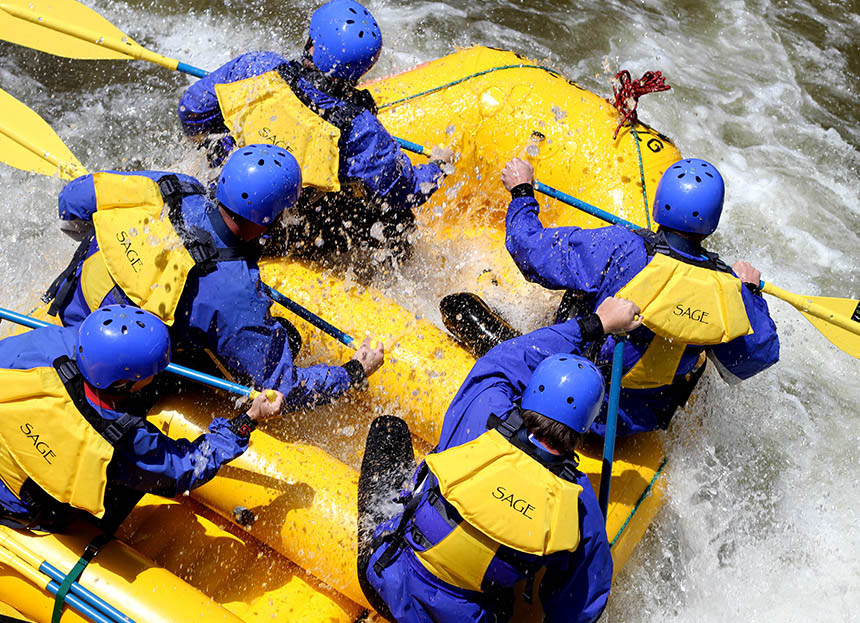DIFFERENT TYPES OF RAFTS AND WHY WE USE THEM

If you’ve been on a guided rafting trip, you may have noticed that rafts come in various setups. Some rafts have a guide using oars in the center. Others place the guide and oars in the back. And some rafts are paddle boats with no oars at all. Each type of boat has its own advantages and disadvantages.
Here’s a quick overview of the different types of raft configurations and why we use them for our whitewater rafting trips in Vail.
Center-Mount Frame Raft
First, consider the raft with a center-mount frame. According to Sage owner and guide Cole Bangert, these rafts are extremely agile since the pivot point of the raft is in the center. You’ll often see this type of setup on overnight camp floats for their ability to navigate big or technical Colorado whitewater rapids with large loads of gear.
Back-Mounted Frame Raft
Next is the raft with its frame and oars mounted at the back. This makes a great paddle-assisted setup, where the guide rows and calls commands to the crew equipped with paddles. Perfect for beginner whitewater rafting in Colorado.
“The paddle crew and guide work together to move the boat,” Cole said. “This is ideal for commercial outfitters. The guide can do most of the work, but guests are still heavily involved. It’s a great setup for family trips with younger kids, as the guide can move the boat without much power from guests.”
Rafts without an Oar Mount
You have probably seen a paddle boat with no oars. This is how most commercial trips are structured. This heavily involves the customers, who must come together as a team to move the raft efficiently.
“The guide and guest must create a trust factor,” Cole told us. “The guide usually could not navigate certain whitewater without the performance of his paddle crew, and the paddle crew must trust that the guide knows how to command the boat. This is fun for the guide and guests alike. There is a lot of teaching and learning.”
Sage’s Custom Rafts
Sage uses a mixture of boats but primarily SOTAR rafts. SOTAR and Sage have teamed up to produce an innovative raft design ideal for our whitewater situations. We worked with SOTAR to build these rafts specifically to maximize performance and fun.
“These custom rafts are 13.5 feet long, and they track well, meaning they move in the direction you point the boat amid heavy waves and currents,” Cole commented. “They are balanced and stable with the 19-inch tube diameter slightly larger than a standard 13-foot raft. The tubes diminish from 19 inches to 15 inches on the tip of the bow and stern to enable the raft to “punch” through big waves without getting stalled out.”
SOTAR also used a high-end material on our custom rafts that, when inflated, turn very stiff. This is crucial to have in hard whitewater. It makes the boat more predictable, faster, and stable for the paddlers. “The height of the bow is also custom,” Cole concluded. “We set it to have a good mixture of speed, anti-deflection, and wetness…because the cause, let’s face it when waves cover the raft, it’s the best feeling ever!”
Your Next Adventure Awaits
Join us and experience the best that Vail has to offer. From the breathtaking views and diverse terrain to the exceptional service and expert guidance, Sage Outdoor Adventures is your gateway to an extraordinary adventure. Contact us today to start planning your next adventure in Vail!

Nick Junker
General Manager
I’m dedicated to leveraging my skills and experiences to make a positive impact in the professional realm.
With a background in Sales and Outdoor Recreation, I’ve navigated through various roles where I’ve honed my expertise in Risk Management, Business Development and Financial Analysis. From Account Executive to General Manager, I’ve cultivated a deep understanding of client and employee relations, Human Resources, Project Management and overall business operations from generating sales to budgeting expenses and managing over 30 employees.
My mission is to create a great culture in any organization I am apart of, through creating efficient industry specific systems within the business that satisfies both employees and investors. Whether it’s through implementing new business systems or managing employee expectations, I’m committed to meeting the goals of the organization.
Known for my strong leadership and organizational skills, I excel in delegating tasks to keep projects and goals on task and on budget. I’m passionate about systems, always seeking innovative solutions to making the business run smoother and more efficiently. I believe in the power of collaboration and enjoy working with diverse individuals to build a strong team thats driven to accomplish the organizations goals.

